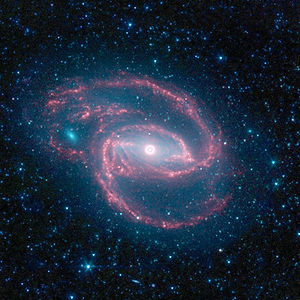- NGC 1097
-
NGC 1097 
Observation data (J2000 epoch) Constellation Fornax Right ascension 02h 46m 19.0s[1] Declination -30° 16′ 30″[1] Redshift 1271 ± 3 km/s[1] Distance 45 million ly [2] Type (R'_1:)SB(r'l)bSy1[1] Apparent dimensions (V) 9′.3 × 6′.3[1] Apparent magnitude (V) 10.2[1] Other designations ESO 416- G 20, PGC 10488,[1] Arp 77[1] Caldwell 67[3] See also: Galaxy, List of galaxies NGC 1097 (also known as Caldwell 67) is a barred spiral galaxy about 45 million light-years away in the constellation Fornax. As of 2006, three supernovae (SN 1992bd, SN 1999eu, and SN 2003B) have been observed in NGC 1097.
NGC 1097 is also a Seyfert galaxy. Deep photographs by Wolstencroft & Zealey (1975), Arp (1976), and Lorre (1978) revealed four narrow optical jets that appear to emanate from the nucleus. Arp interpreted these as manifestations of the (currently weak) active nucleus. Subsequent analysis of the brightest jet's radio-to-X-ray spectral energy distribution by Carter, Allen & Malin (1984), Wehrle, Keel, & Jones (1997) and Higdon & Wallin (2003) were able to rule out synchrotron and thermal free-free emission. The jets are in fact composed of stars. The failure to detect atomic hydrogen gas in the jets (under the assumption that they were an example of tidal tails) using deep 21 cm HI imaging with the Very Large Array radio telescope and numerical simulations led to the current interpretation that the jets are actually the shattered remains of a cannibalized dwarf galaxy (Higdon & Wallin 2003).
Like most massive galaxies, NGC 1097 has a supermassive black hole at its center. Around the central black hole is a ring of star-forming regions with a network of gas and dust that spirals from the ring to the black hole.
NGC 1097 has two satellite galaxies. Dwarf elliptical galaxy NGC 1097A is the larger of the two. It is a peculiar elliptical galaxy that orbits 42,000 light-years from the center of NGC 1097. Dwarf galaxy NGC 1097B, the outermost one, was discovered by its HI emission (5 x 10^6 solar masses; Higdon & Wallin 2003), and appears to be a typical dwarf irregular. Little else is known about it.
Contents
Gallery
-
Two galaxies, about 50 million light-years away, are locked in a galactic embrace.[4] Credit ESO.
-
Star forming ring in NGC 1097. HST. 0.9′ view
See also
- Spiral Galaxy NGC 1300
- Spiral Galaxy NGC 1232
References
- ^ a b c d e f g h "NASA/IPAC Extragalactic Database". Results for NGC 1097. http://nedwww.ipac.caltech.edu/. Retrieved 2006-11-25.
- ^ "Feeding the Monster: New VLT Images Reveal the Surroundings of a Super-massive Black Hole". European Southern Observatory. http://www.eso.org/public/outreach/press-rel/pr-2005/phot-33-05.html. Retrieved 2008-03-15.
- ^ O'Meara, Stephen James (2002). The Caldwell Objects. Cambridge University Press. ISBN 0-521-82796-5.
- ^ "A Galactic Embrace". ESO. http://www.eso.org/public/images/potw1128a/. Retrieved 13 July 2011.
External links
- VLT observations – NGC 1097's "dog-leg" tidal stream
- weblore.com – NGC 1097: The Galaxy with the Longest known Optical Jets
- Antilhue-Chile – NGC 1097 in Fornax
- ESO – Very Large Telescope observations of NGC 1097
- Astronomy Picture of the Day – In the Arms of NGC 1097 (2006-12-01)
- NGC 1097 on WikiSky: DSS2, SDSS, GALEX, IRAS, Hydrogen α, X-Ray, Astrophoto, Sky Map, Articles and images
Astronomical catalogs NGC: NGC 1095 - NGC 1096 - NGC 1097 - NGC 1098 - NGC 1099 PGC: PGC 10486 - PGC 10487 - PGC 10488 - PGC 10489 - PGC 10490 Caldwell: C65 - C66 - C67 - C68 - C69 Arp: Arp 75 - Arp 76 - Arp 77 - Arp 78 - Arp 79 Coordinates:
 02h 46m 19.0s, −30° 16′ 30″
02h 46m 19.0s, −30° 16′ 30″The Caldwell catalogue List C1 · C2 · C3 · C4 · C5 · C6 · C7 · C8 · C9 · C10 · C11 · C12 · C13 · C14 · C15 · C16 · C17 · C18 · C19 · C20 · C21 · C22 · C23 · C24 · C25 · C26 · C27 · C28 · C29 · C30 · C31 · C32 · C33 · C34 · C35 · C36 · C37 · C38 · C39 · C40 · C41 · C42 · C43 · C44 · C45 · C46 · C47 · C48 · C49 · C50 · C51 · C52 · C53 · C54 · C55 · C56 · C57 · C58 · C59 · C60 · C61 · C62 · C63 · C64 · C65 · C66 · C67 · C68 · C69 · C70 · C71 · C72 · C73 · C74 · C75 · C76 · C77 · C78 · C79 · C80 · C81 · C82 · C83 · C84 · C85 · C86 · C87 · C88 · C89 · C90 · C91 · C92 · C93 · C94 · C95 · C96 · C97 · C98 · C99 · C100 · C101 · C102 · C103 · C104 · C105 · C106 · C107 · C108 · C109See also Categories:- Barred spiral galaxies
- Fornax Cluster
- Fornax constellation
- NGC objects
- PGC objects
- Arp objects
- Caldwell objects
-
Wikimedia Foundation. 2010.




